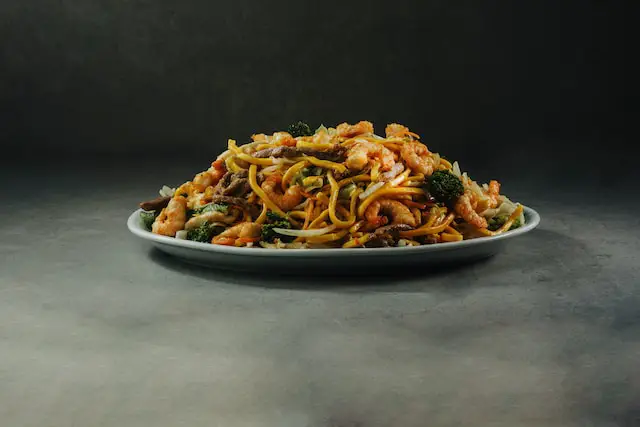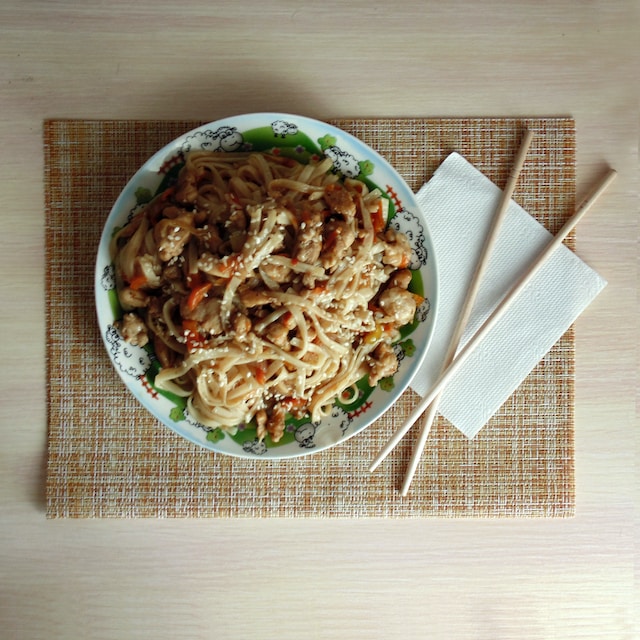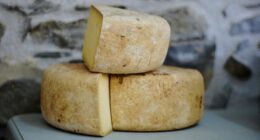Yakisoba noodles and udon noodles are two popular Japanese dishes that have their unique characteristics. Yakisoba is made with wheat flour and has a thinner texture than udon, while udon is made with thicker wheat flour.
Yakisoba noodles
(Photo by Douglas Lopez on Unsplash )

Yakisoba noodles are a popular Japanese dish that typically consists of stir-fried wheat noodles, vegetables and meat or seafood. These curly yellow noodles have a slightly chewy texture and absorb flavors well, making them perfect for savory dishes.
One thing that sets yakisoba apart from other noodle dishes is its unique seasoning sauce made with Worcestershire sauce, soy sauce, oyster sauce and sometimes ketchup. This combination creates a tangy yet sweet flavor that complements the ingredients perfectly.
Yakisoba can be cooked in various ways – some people like to make it with pork or chicken while others prefer shrimp or tofu. Vegetables such as cabbage, carrots and onions are also commonly used in preparing this dish.
In Japan, yakisoba is often served at festivals and street fairs where vendors cook the noodles on large griddles right in front of customers. It’s an iconic food item in Japan that has become widely loved around the world for its delicious taste and versatility.
Udon noodles
(Photo by Jinomono Media on Unsplash )

Udon noodles are thick, chewy, and incredibly versatile. They are made from wheat flour, salt, and water, which gives them a unique texture that sets them apart from other Japanese noodle varieties. Udon is often used in soups but can also be enjoyed stir-fried or dipped in sauce.
One of the most distinctive features of udon noodles is their thickness. This makes them ideal for soaking up sauces and broths while still maintaining their chewiness. In Japan, udon is commonly served in hot dashi broth with toppings such as tempura shrimp or vegetables.
While udon may seem like a simple dish at first glance, it actually has many regional variations across Japan. Each region has its own unique way of preparing and serving the dish with different sauces and toppings.
Udon noodles can also be found beyond Japan’s borders thanks to their growing popularity worldwide. Many restaurants around the globe have included this hearty noodle dish on their menus as an alternative to other Asian-style dishes.
Udon noodles are a delightfully filling option that offers diverse flavors depending on how they’re prepared – whether you enjoy it as part of a soup or stir-fry!
Yakisoba noodles Vs. Udon noodles – Key differences
When it comes to Japanese noodles, two of the most popular varieties are yakisoba and udon. While both may seem similar at first glance, they have some distinct differences that set them apart.
Firstly, the texture of these noodles is different. Yakisoba typically has a thinner and more delicate texture compared to the thicker and chewier udon noodle. This difference in texture can impact how well each type holds up when cooked in different dishes.
Another key difference is their flavor profile. Yakisoba often has a tangy and slightly sweet taste due to its sauce made with soy sauce, Worcestershire sauce, and sugar. Udon noodles have a more neutral flavor which allows them to absorb the flavors of the broth or other ingredients they’re cooked with.
In terms of cooking methods, yakisoba is usually stir-fried on high heat while udon noodles are typically boiled or served in soup dishes.
While these two types of noodles may look similar at first glance, they offer unique textures, flavors and cooking methods that make them stand out from one another.
Which is better yakisoba or udon?
When it comes to deciding whether yakisoba or udon noodles are better, personal preference plays a big role. Both types of noodles have their own unique characteristics and flavors that make them stand out.
Yakisoba noodles are thin and slightly chewy, with a salty and savory flavor. They’re often stir-fried with vegetables, meat, and sauce for a delicious meal that’s quick and easy to prepare. The texture of yakisoba is perfect for absorbing the flavor of the sauce it’s cooked in.
On the other hand, udon noodles are thick and soft with a mild taste that pairs well with both light broths or heavy sauces. Udon is versatile enough to be used in soups as well as stir-fries but takes longer to cook than yakisoba due to its thickness.
Ultimately which noodle is better depends on what you’re looking for in your dish; if you want something savory and quick then go for the Yakisoba but if you prefer something hearty then Udon might be more up your alley!
What makes yakisoba different?
Yakisoba noodles are different from other Japanese noodles like udon and ramen for several reasons. One of the main differences is that yakisoba noodles are made with wheat flour, whereas udon and ramen can be made with a variety of flours.
Another difference is in their texture – Yakisoba noodles have a chewy texture, similar to Italian pasta, while udon has a soft and thick texture. Additionally, yakisoba is typically stir-fried with vegetables such as cabbage, onions and carrots along with protein like pork or chicken.
The seasoning used in Yakisoba also distinguishes it from other Japanese noodle dishes. A Worcestershire-based sauce called “sauce” is commonly used to flavor yakisoba giving it its signature taste.
Yakisoba can also be customized according to one’s preference by adding ingredients such as seafood or mushrooms making the dish quite versatile.
What makes yakisoba different from other popular Japanese noodle dishes like Udon lies in its unique combination of wheat-flour based noodles flavoured with Worcestershire-sauce accompanied by stir-fried vegetables making it an easy-to-make yet deliciously satisfying meal option!
Why is it called yakisoba?
Yakisoba noodles are a staple dish in Japanese cuisine, loved for their savory flavors and chewy texture. But have you ever wondered why it’s called “yakisoba”? The word “soba” means buckwheat noodles in Japan, but yakisoba is made from wheat flour instead.
The origin of the name comes from the words “yaki,” meaning grilled or fried, and “soba.” This refers to how the dish is prepared by stir-frying boiled noodles with vegetables and meat on a hot skillet or griddle.
Interestingly enough, despite its name, yakisoba doesn’t actually contain any soba (buckwheat) at all! It’s one of those quirks in language that can cause confusion for non-Japanese speakers.
Why is it called udon?
Udon is believed to have originated from China during the Tang Dynasty and was introduced to Japan around 700 AD. However, the exact origin of the word “udon” is not clear.
One theory suggests that “udon” comes from the combination of two Japanese words: udu, meaning knead or work with hands, and fu, meaning wheat gluten. Another theory suggests that it comes from the old Japanese word for flour, which was called undama.
Despite its unclear origin, one thing we know for sure is that udon has become an integral part of Japanese culture and cuisine. It’s a versatile noodle that can be served hot or cold with various toppings such as tempura shrimp or beef.
Udon noodles come in different thicknesses ranging from thin to thick depending on which region of Japan you’re in. For example, Sanuki udon is known for its chewy texture due to using harder water in Kagawa prefecture while Kansai-style udon uses softer water resulting in lighter and fluffier noodles.
Featured Image By – Matvey Smirnov on Unsplash








